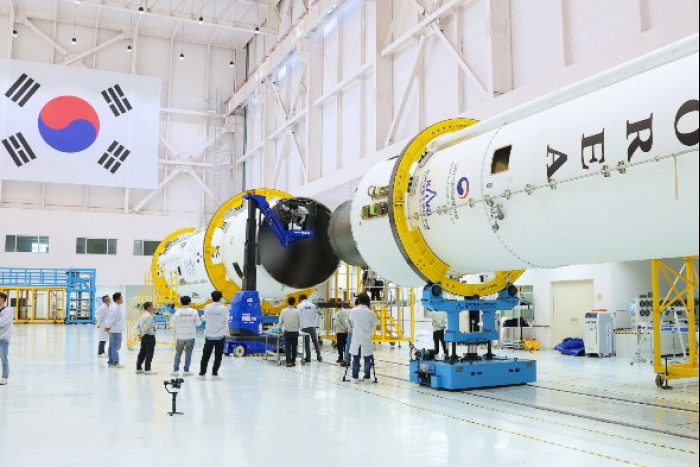S.Korea sets Nuri space rocket’s third launch on May 24
This is the first attempt to launch practical satellites, capable of Earth observation
By Apr 11, 2023 (Gmt+09:00)
LG Chem to sell water filter business to Glenwood PE for $692 million


KT&G eyes overseas M&A after rejecting activist fund's offer


Kyobo Life poised to buy Japan’s SBI Group-owned savings bank


StockX in merger talks with Naver’s online reseller Kream


Meritz backs half of ex-manager’s $210 mn hedge fund



South Korea will conduct a third attempt to launch its first domestically designed and developed space rocket Nuri on May 24.
The Korean launch vehicle Nuri 3 (KSLV-II FM3) will be launched on May 24 at 6:24 p.m. The preliminary launch period was set to between May 25 and 31 in consideration of the possibility of changing the launch schedule in the event of some issues, such as unfavorable weather conditions.
The Korea Aerospace Research Institute and Hanwha Aerospace Co. have completed the process of assembling the first and second stages and is undergoing various performance tests. The eight satellites to be mounted on the third stage will be delivered to the Naro Space Center early next month and final assembly work will be carried out for three weeks.
The satellites, which will be loaded on the Nuri rocket, are being tested for the space environment. These are practical satellites, not mock-ups, capable of Earth observation.
The main purpose of this launch is to put the No. 2 next-generation small-size satellite developed by Korea's own technology into orbit. The satellite, which was completed in October last year with a budget of 24 billion won ($18.1 million) invested by the KAIST Satellite Research Institute, has a total weight of 170 kg and a length of 5.2 m when the antenna is deployed.
It will perform ground observation missions for two years while orbiting at an altitude of 550 km. It is noteworthy that a small-sized synthetic aperture radar (SAR) made with domestic technology will be used. SAR is not affected by light or clouds, enabling day and night ground observation even during severe weather. The maximum resolution is 5 m, and the observation width is 40 km.
The deployment of the cluster satellite SNIPE (Scale MagNetospheric and Ionospheric Plasma Experimen) into orbit is also one of the main missions of Nuri rocket. It's developed by the Korea Astronomy and Space Science Institute, consists of four nano-satellites weighing 10 kg each and with a size of 6U (10×20×30 cm). SNIPEt will observe near-Earth plasma phenomena (aurora) at distances of around 10-100 km apart in formation flight in the 500 km orbit.
Write to Jin-Won Kim at jin1@hankyung.com
-
 Aerospace & DefenseHanwha Aerospace to launch 4 more Nuri rockets under $220 mn project
Aerospace & DefenseHanwha Aerospace to launch 4 more Nuri rockets under $220 mn projectDec 02, 2022 (Gmt+09:00)
2 Min read -
 Aerospace & DefenseS.Korea’s first mission to the Moon, Danuri, enters transfer orbit
Aerospace & DefenseS.Korea’s first mission to the Moon, Danuri, enters transfer orbitAug 05, 2022 (Gmt+09:00)
2 Min read -
 Aerospace & DefenseKorea sets Nuri space rocket’s second launch for mid-June
Aerospace & DefenseKorea sets Nuri space rocket’s second launch for mid-JuneFeb 25, 2022 (Gmt+09:00)
2 Min read -
 Aerospace & DefenseKorea’s Nuri: Mission unaccomplished, but one step closer to space
Aerospace & DefenseKorea’s Nuri: Mission unaccomplished, but one step closer to spaceOct 21, 2021 (Gmt+09:00)
5 Min read


